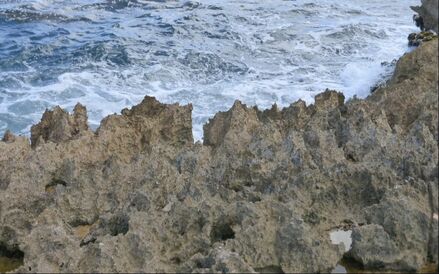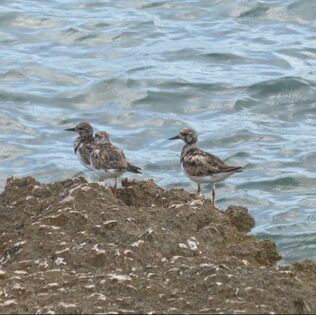On this dry tropical coastline, scattered thorn trees, cactus, and dry brush run nearly to the water’s edge. Where shallow soil gives way to rough, bare rock torn by the waves, salt spray continually refills pools scattered over the algae-stained limestone.
Dimensions The bare rock surface lies 2-10 feet (0.5-3 m) above waterline. Soil and vegetation take hold about 30 feet (10 m) inland. The water is less than 3 feet (1 m) deep for some distance offshore, with patches of gravel and hard rock bottom.
Key Details
- This shore is in fairly humid tropics, but downwind of mountains whose rain forests catch most of the moisture.
- Tides are muted here – the bare strip of rock surface fronting the shoreline lacks soil-holding plants because of salt spray and splash from high waves.
- Along the shore a flat layer of limestone has been stripped back by waves, as well as being dissolved by water and other biological/chemical corrosion. Submerged rock layers remain in place, extending out further from the shoreline. The erosion is especially strong right where the water surface meets the rock edge, so that in many places there is a horizontal notch a cut in few feet (1 m) at the waterline, with a few inches to two feet (tens of cm) of vertical clearance.
- The water's dissolving action on the flat rock surface has made it rougher. Over the centuries, the rock has been more deeply dissolved out in spots where water stayed puddled - not only was there more time for the water to dissolve the rock there, but plant and animal life in the spray-filled pools made their own chemical and rock-fragmenting contributions. Shallow depressions became deep pits with sharp edges, leaving higher dry rock areas in between. In some spots near the water's edge, the grapefruit-sized pits are spaced so closely that they are only separated by sharp-topped ridges and points of the rock that stand several inches (approx. 10 cm) high, a real danger to fall upon.
- More broadly, the broken, irregular rock surface presents many trip hazards; running any distance over it would court injury.
- The shore is difficult for a swimmer to approach when waves are even moderately active. There is a good chance of bruises and scrapes from tumbling and colliding with the rough, broken bedrock, and possible entanglement in the waterline notch.
- The variety of desert plants in the patchy vegetation areas includes several types of cactus, serrated-blade agaves (including the tall-stalked mature 'century' plant that flowers only after a couple of decades), and thorn trees with spikes 2-3 inches (5-7 cm) long. Winding through the scattered brush while avoiding contact with thorns and needles at head, waist, and ankle levels simultaneously, takes some attention.
- Other areas are covered with dense, dry brush standing well above head height. This can only be pushed through with difficulty, and limits sight distance to a few yards/meters. Cactus are less common here, but ones at ground level may be less easily seen and avoided.
- More broadly, this shore includes short stretches of beach at slight indentations of the coast, and higher sea cliffs on some headlands rising up to 20 feet (6 m) above the water.
- The desert shore provides roosts for dozens of types of songbirds and shore birds, some of which are unique to the region. Crabs occupy 1 in- (2 cm-) diameter holes in the beach face, and snails are abundant at waterline on the rock surface. Despite this being a dry place, salt-water mosquitoes can be vicious in some seasons.
Story Elements

- The visual contrast of parched land and open water here hides a similarity, that both the desert soil and tropical waters are scarce in nutrients, low in biological mass and high in biodiversity. These themes of apparent want and hidden richness might connect to the larger story.
- Many tiny inlets and random rock depressions make this a good place for something dropped, or washed up, to hide from cursory view. A stroller might see it only when nearly standing on it. The shoreline notch might hide something fairly large from view entirely, unless seen while swimming or standing in the water.
- The opaque clumps of dry brush, clothes-grabbing thorn branches and cactus spines, and shoreline patches of spiky pitted rock make this a dynamic place for a fight scene. On a calm-water day, characters might temporarily hide in company with snails and algae in a waterline notch.
- People might frequent this location to harvest small creatures, algae, or concentrated brine from the rock pools. They might develop specific uses for abundant cactus spines and tree thorns, or harvest fluids from century plant stalks that can be processed into an intoxicating beverage. In current day, bird watchers make this a travel destination.
- "Water, water everywhere, / Nor any drop to drink." This terrain is unlikely to provide any opportunity for hydration. Cactus fruit (not the caustic flesh or sap) may be a source, if available. While the ground surface becomes parched again within hours of any significant rainfall, rock-surface pits that are furthest from the ocean's edge may retain puddles of reasonably fresh water over the next couple of days.
- Warm, dry rock beside a small pool would be a wonderful place for a character to sit and reflect. The life in the pool might be seen as a microcosm of the vast ocean spread out before a viewer. Tiny ripples in the pool might be compared against the waves on the ocean in their scale, distance traveled, tranquility/violence, simplicity/complexity of pattern. A pool might be used as an impromptu crude map, as a small group conceives a trip across the sea.
- Characters might cross through the vegetation to the water’s edge in evening light, but need to return inshore through the thorny growth in the dark.
Reference Location
Guanica Dry Forest Reserve, southwestern Puerto Rico. Many places on the coast are accessible on paved and gravel Reserve access roads, where some beach areas have been lightly developed for recreation. Some inland portions of this large reserve can be reached from through roads connecting area towns. Bring a drinking water supply in for all visits. Nearby, 20 miles to the west is the Mangrove Cays scene location.
© Rice-Snows 2017
Proudly powered by Weebly










